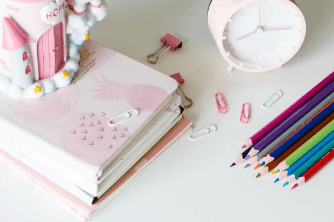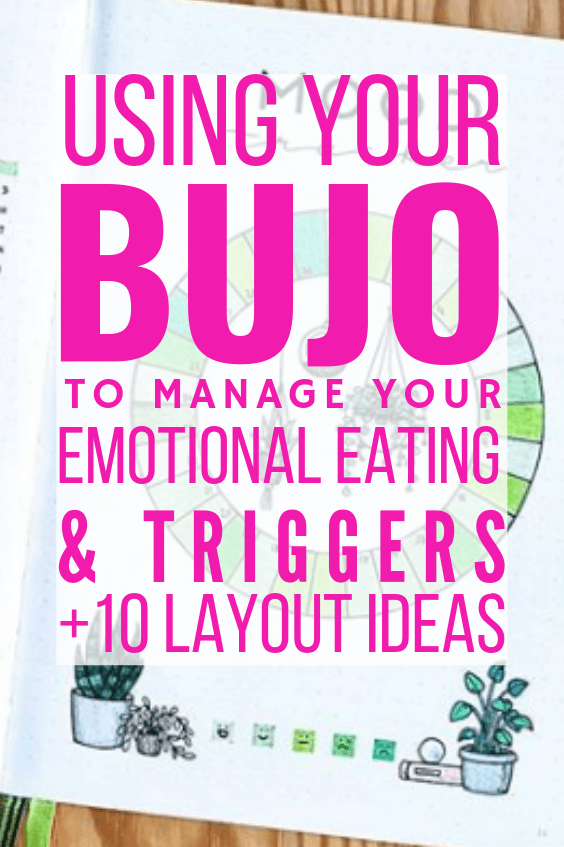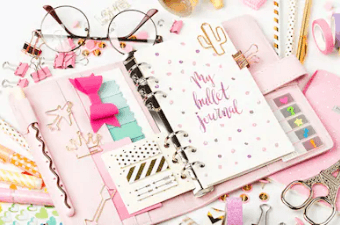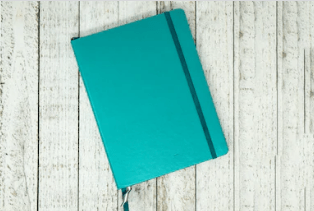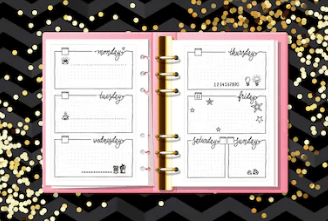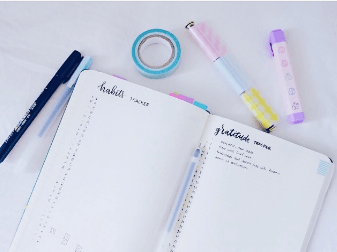
Using Your Bullet Journal to Manage Emotional Eating with Trigger Trackers & 10 Layouts

This simple little book and the system you set up can be used to manage every part of your life. Bullet Journaling as a whole is beneficial. Adding in trackers to keep you accountable is even better.
Before we get to that, in case you haven't started a journal yet, let's go over the basics.
How to Make and Use a Bullet Journal
Of all the journaling methods around, the bullet journal is the easiest but with the most confusion surrounding it. You may have seen a bullet journal before and thought that you could do it, only to find they require more work than you can deal with at the time.
The truth is, once you know how to make your own bullet journal, and how to use it properly, you can create an effective way to organize your life. Here are some simple steps to making and using a bullet journal effectively.
What you need to start:
Before you move into the lovely bullet journal spreads I have to show you, I want to recommend some of the products I use for my own bullet journaling.
- This is the exact Bullet Journal I use.
- These are the markers I personally use. You can go with fancy Tombows but I like these.
- These are the stencils I use. They are metal with their own case.
- This is the washi tape I use. I like skinny tape.
The Set-Up of a Bullet Journal
A bullet journal is different than most types of journals. The initial set-up is to determine what symbols you will use in the journal. A bullet, for example, may simply be to mark something that you need to do.
You may then want to use an asterisk to mark something that is a long-term goal. This will go on until you have a symbol for each thing you want to track such as your daily to-do list, long-term goals, short-term goals, and even financial goals. You will need to put these symbols in an index to keep track of what you are doing.
When to Use a Bullet Journal
You should be using your bullet journal on a daily basis just as you would an agenda book or planner. When you make your index and you start the journal, make sure you have a date at the top of the page. Mark off what you have accomplished each day. At the end of the day, start the new day by moving the uncompleted tasks over to the next day.
How the Bullet Journal Helps You
The bullet journal is primarily there to help you with organizing your tasks. It is for the person who procrastinates or who has far too much on their plate to keep up with. It helps you organize your goals, keep them in line, and keep on top of them in order to make sure they reach their goals.
You will also find that it helps you declutter your mind and your life as you get used to the journal and what works best for you.
Keep in mind, bullet journaling is ideally for someone that needs assistance with organizing and getting things done. It can be useful for other things, but primarily it is a tool used for organizing goals and meeting those goals.
How to Make and Use an Emotional Eating Journal
Emotional eating can lead to severe health issues and eating disorders. It is one of the leading reasons that people have an issue with dropping weight. You can stay on your healthy eating plan until your emotions get the better of you and the only way to work through them seems to be food.
If emotional eating is causing issues in your life, but you can't seem to stop doing it, there may be an answer through journaling. Here is how to make and use an emotional eating journal to help you stop the pattern.
The Set-Up of an Emotional Eating Journal
You can use whatever type of journal you would like. The material isn't the main issue with an emotional eating journal. What is important is how it is set-up. You need a section for what you are eating, the date, the time, and then an area to let you write out what may have lead you to the emotional eating incident.
You may not think the foods you are eating are important, but some people have found that certain foods are more comforting and that the memory of those foods is connected to the trigger of the emotional eating.
For example, you may find that eating grilled cheese sandwiches are comforting during an emotional eating binge. Once you start journaling, you may find that the reason they are is because someone was verbally abusive in your past and that verbal abuse was always followed by a grilled cheese to make you feel better.
When to Use an Emotional Eating Journal
You should use the emotional eating journal when you feel the need to eat after having a triggering event occur. This may mean that you are journaling during emotional eating. That is fine.
You can do that or you can use it in place of eating. Once you start using the journal on a routine basis you will find that you reach for it instead of food, or that you are eating less because you are writing more.
How the Emotional Journal Helps You
Emotional eating journals help you by reducing the amount you are eating during that moment. They also help you write down your thoughts, which means you can get to the root of the problem.
This allows you to find out what is triggering you, what it is triggering you, and why you are being triggered to eat instead of other emotional responses.
The key point to remember with emotional eating journaling is timing. You need to journal when you feel the need to eat. For the first few entries, you may find yourself eating while journaling and that is okay.
The point is to do it when you start the emotional eating so you can work through the issue in a healthier way.
How to Make and Use a Trigger Tracking Journal
Being triggered is a phrase that is used in social media, news reports, and in daily conversation. The phrase refers to the emotional reaction you may have to certain topics. You may become upset, violent, afraid, or a mixture of all emotions depending on the topic.
The bigger issue with being triggered is when you don't know why you were triggered or how to deal with it. That is where a trigger tracking journal comes in. If this sounds like something you are willing to try, here is some information on how to make and use a trigger tracking journal.
The Set-Up of a Trigger Tracking Journal
Trigger tracking journals are a bit different than other journals in the sense there is no real set-up. They are designed for you to pour out your thoughts as they come to you. They are meant to be an area to rant and rave about what has occurred and what has triggered you.
You are also meant to write down how you are triggered. Let it all out including how you feel, why you feel that way, and anything at all that comes to mind. This is for your eyes only, so don't hold back. Just say what you feel because it all connects back to the trigger itself.
When to Use a Trigger Tracking Journal
Trigger tracking journals are an immediate response journaling method. You don't want to wait to write in the journals. You want to do it at the time you feel the emotion. This allows you to get your thoughts out without really thinking them over and without removing some of the thoughts you are having because you feel they are wrong or bad.
If possible, use the journal at the moment or just following the moment. The longer you wait to use this type of journal, the less effective it is.
How the Trigger Tracking Journal Helps You
Trigger tracking journals work in several ways. The first is to give you an immediate outlet for the emotions you are feeling from being triggered. The second way they are used is to give you something to reflect on.
You should go back and look at the entries at least once a week and make one entry about your thoughts on the previous week’s entries. The third way this helps is by helping you see who or what is triggering you on a routine basis. This allows you to begin to remove that from your daily life and help you reduce triggers and stress.
Related Posts: 11 Life-Saving Bullet Journal Ideas That Will Get Your Finances In Order
Crush Your Health & Fitness Goals With 10 Bullet Journal Habit Trackers
Bullet Journal 101: What you need & Gorgeous Layouts To Inspire You To Start
Now let’s get you looking at these awesome mood and food log bujo spreads...
You can use nearly anything to keep track and journal. Keep in mind, you want to use a journaling method that is easy to grab, easy to write in, and easy to carry with you. You never know when you may feel triggered and having an option with you is the best way to combat it if journaling works for you. Let me know if this helped you understand emotional eating and how using your journal can help manage it.
